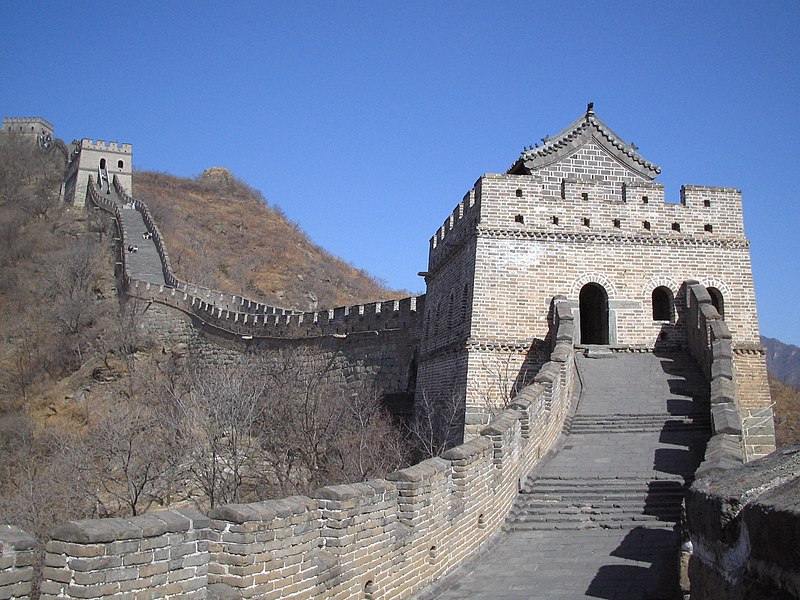The Great Wall (Simplified Chinese: 万里长城) is a series of stone and earthen fortifications in China, built, rebuilt, and maintained between the 5th century BC and the 16th century to protect the northern borders of the Chinese Empire during the rule of successive dynasties. Several walls, referred to as the Great Wall of China, were built since the 5th century BC, the most famous being the one built between 220 BC and 200 BC by the first Emperor of China, Qin Shi Huang. That wall was much farther north than the current wall, built during the Ming Dynasty, and little of it remains.
The Great Wall is the world's longest human-made structure, stretching over approximately 6,400 km (4,000 miles) from Shanhai Pass in the east to Lop Nur in the west, along an arc that roughly delineates the southern edge of Inner Mongolia. It is also the largest human-made structure ever built in terms of surface area and mass.
While some portions north of Beijing and near tourist centers have been preserved and even reconstructed, in many locations the Wall is in disrepair. Those parts might serve as a village playground or a source of stones to rebuild houses and roads. Sections of the Wall are also prone to graffiti and vandalism. Parts have been destroyed because the Wall is in the way of construction. No comprehensive survey of the wall has been carried out, so it is not possible to say how much of it survives, especially in remote areas. Intact or repaired portions of the Wall near developed tourist areas are often frequented by sellers of tourist kitsch.
The wall also has watch towers at regular intervals, which were used to store weapons, house troops, and send smoke signals. Barracks and administrative centers are located at larger intervals.
Communication between the army units along the length of the Great Wall, including the ability to call reinforcements and warn garrisons of enemy movements, was of high importance. Signal towers were built upon hill tops or other high points along the wall for their visibility.
The Great Wall is visibility from the moon.


 TravelYourself
TravelYourself
The Forbidden City was the Chinese imperial palace from the mid-Ming Dynasty to the end of the Qing Dynasty. It is located in the middle of Beijing, China. It now houses the Palace Museum.
Built from 1406 to 1420, the complex consists of 980 surviving buildings with 8,707 bays of rooms and covers 720,000 square metres. The palace complex exemplifies traditional Chinese palatial architecture, and has influenced cultural and architectural developments in East Asia and elsewhere. The Forbidden City was declared a World Heritage Site in 1987, and is listed by UNESCO as the largest collection of preserved ancient wooden structures in the world.
Since 1924, the Forbidden City has been under the charge of the Palace Museum, whose extensive collection of artwork and artefacts were built upon the imperial collections of the Ming and Qing dynasties. Part of the museum's former collection is now located in the National Palace Museum in Taipei. Both museums descend from the same institution, but were split after the Chinese Civil War.
Since 1924, the Forbidden City has been under the charge of the Palace Museum, whose extensive collection of artwork and artefacts were built upon the imperial collections of the Ming and Qing dynasties. Part of the museum's former collection is now located in the National Palace Museum in Taipei. Both museums descend from the same institution, but were split after the Chinese Civil War.Currently, the Palace Museum is responsible for the preservation and restoration of the Forbidden City. Building heights around the Forbidden City are restricted. In 2005, a sixteen-year restoration project was started to repair and restore all buildings in the Forbidden City to their pre-1912 state. This is the largest restoration of the Forbidden City undertaken in two centuries, and involves progressively closing off sections of the Forbidden City for assessment, repairs, and restoration. As part of the project, some derelict or destroyed sections such as the gardens of the Palace of Establishing Prosperity will be re-built. While great effort has been made to prevent the commercialisation of the palace, a variety of commercial enterprises exist, such as souvenir shops and photography stands. These commercial enterprises often rouse controversy. A new Starbucks store has sparked objections, while souvenir shops that refuse to serve Chinese citizens have received media attention.







